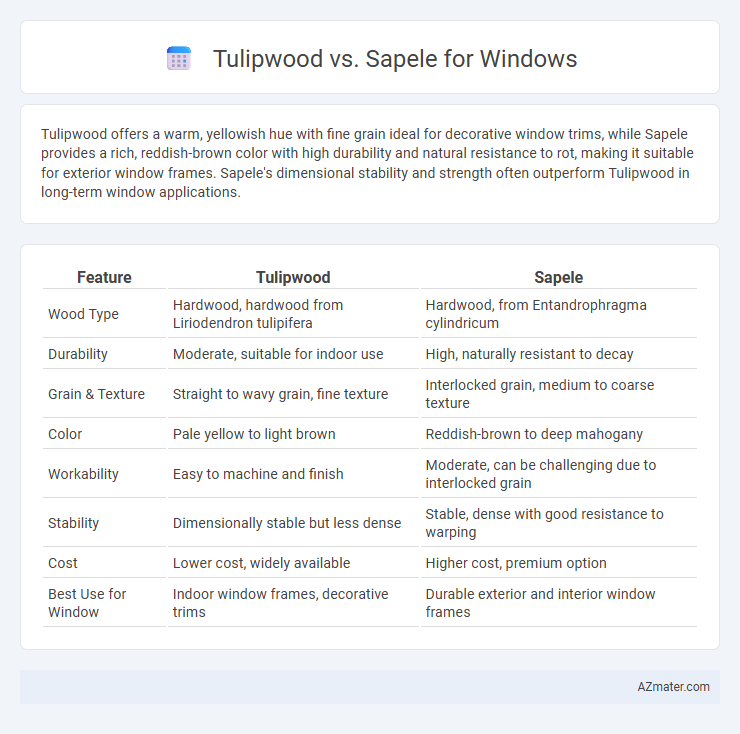Tulipwood offers a warm, yellowish hue with fine grain ideal for decorative window trims, while Sapele provides a rich, reddish-brown color with high durability and natural resistance to rot, making it suitable for exterior window frames. Sapele's dimensional stability and strength often outperform Tulipwood in long-term window applications.
Table of Comparison
| Feature | Tulipwood | Sapele |
|---|---|---|
| Wood Type | Hardwood, hardwood from Liriodendron tulipifera | Hardwood, from Entandrophragma cylindricum |
| Durability | Moderate, suitable for indoor use | High, naturally resistant to decay |
| Grain & Texture | Straight to wavy grain, fine texture | Interlocked grain, medium to coarse texture |
| Color | Pale yellow to light brown | Reddish-brown to deep mahogany |
| Workability | Easy to machine and finish | Moderate, can be challenging due to interlocked grain |
| Stability | Dimensionally stable but less dense | Stable, dense with good resistance to warping |
| Cost | Lower cost, widely available | Higher cost, premium option |
| Best Use for Window | Indoor window frames, decorative trims | Durable exterior and interior window frames |
Introduction to Tulipwood and Sapele
Tulipwood, sourced primarily from the Liriodendron tulipifera tree, is prized for its light color, fine grain, and excellent workability, making it a popular choice for window frames and trim. Sapele, derived from the African Sapele tree, is a dense hardwood known for its rich reddish-brown hue, durability, and natural resistance to decay, often used in high-end window construction for its aesthetic appeal and longevity. Both woods offer distinct advantages in terms of strength and appearance, catering to different architectural styles and performance requirements.
Botanical Origins and Sources
Tulipwood, derived from the Liriodendron tulipifera tree native to eastern North America, features a light, creamy texture ideal for window frames requiring durability and aesthetic appeal. Sapele, sourced from the Entandrophragma cylindricum species found primarily in West Africa, offers a rich reddish-brown tone with a fine grain that enhances window structures with both strength and decorative elegance. Both woods have distinct botanical origins that influence their sourcing, sustainability, and suitability for high-quality window construction.
Color and Grain Appearance
Tulipwood exhibits a light, creamy yellow to pale pink hue with fine, straight grain creating a smooth, uniform appearance ideal for bright, modern window frames. Sapele features a richer, reddish-brown color with a distinctive interlocking grain pattern that produces a striking figure and natural luster, lending a more traditional and elegant look to windows. When choosing between the two, Tulipwood is preferred for lighter, subtle aesthetics, while Sapele provides deeper warmth and visual texture in window design.
Workability and Machinability
Tulipwood offers excellent workability with its relatively soft texture, making it easy to cut, shape, and sand for window frames. Sapele, being a hardwood with a tighter grain, provides good machinability but requires sharper tools and slower feed rates to prevent tearing or chipping. Both woods offer durability, but Tulipwood's ease of carving and finishing often makes it preferred for intricate window designs.
Durability and Resistance to Decay
Tulipwood offers moderate durability with a Janka hardness around 720, making it suitable for window frames but less resistant to decay compared to Sapele. Sapele, a hardwood with a Janka rating near 1,410, provides superior durability and natural resistance to rot and insect damage, ideal for window applications in humid environments. Its dense grain structure also enhances long-term performance, maintaining structural integrity and aesthetic appeal over time.
Environmental Impact and Sustainability
Tulipwood and Sapele are both valued hardwoods, but Tulipwood typically comes from faster-growing trees, making it a more renewable choice with lower environmental impact due to reduced deforestation pressure. Sapele, often harvested from slower-growing African forests, can contribute to habitat loss and biodiversity decline if not sourced sustainably. Choosing FSC-certified Tulipwood or Sapele ensures responsible forestry practices, supporting long-term ecosystem health and minimizing carbon footprint associated with window materials.
Cost Comparison for Window Projects
Tulipwood typically costs less than sapele for window projects, making it a budget-friendly choice without sacrificing structural integrity. Sapele, with its richer color and durability, commands a higher price but offers added aesthetic appeal and long-term resilience against weathering. Choosing between tulipwood and sapele depends on balancing upfront material costs with desired window longevity and visual impact.
Finishing and Maintenance Requirements
Tulipwood offers a smooth grain that accepts finishes uniformly, creating a sleek appearance with moderate maintenance, typically requiring periodic sealing or varnishing to protect against moisture and UV damage. Sapele features a dense, interlocking grain that provides a natural sheen and durability but demands more careful sanding and regular oiling or varnishing to maintain its rich color and resist weathering. Both woods respond well to finishing products but Sapele's higher natural oils necessitate thorough surface preparation to ensure finish adhesion and longevity.
Insulation and Thermal Performance
Tulipwood offers moderate insulation properties with a Janka hardness of 950, making it suitable for window frames in mild climates. Sapele, with a density of approximately 640 kg/m3 and higher thermal mass, provides better thermal performance and energy efficiency by reducing heat transfer. Both woods are durable, but Sapele's superior insulation makes it the preferred choice for windows in regions requiring enhanced thermal regulation.
Best Applications: Choosing Between Tulipwood and Sapele for Windows
Tulipwood offers lightweight durability and a fine, uniform grain making it ideal for window frames requiring easy installation and smooth finishing. Sapele provides superior hardness and natural resistance to decay, perfect for exterior window frames exposed to harsh weather conditions. Choosing between Tulipwood and Sapele depends on application priorities: interior window trim benefits from Tulipwood's workability, while Sapele excels in structural strength and outdoor durability.

Infographic: Tulipwood vs Sapele for Window
 azmater.com
azmater.com